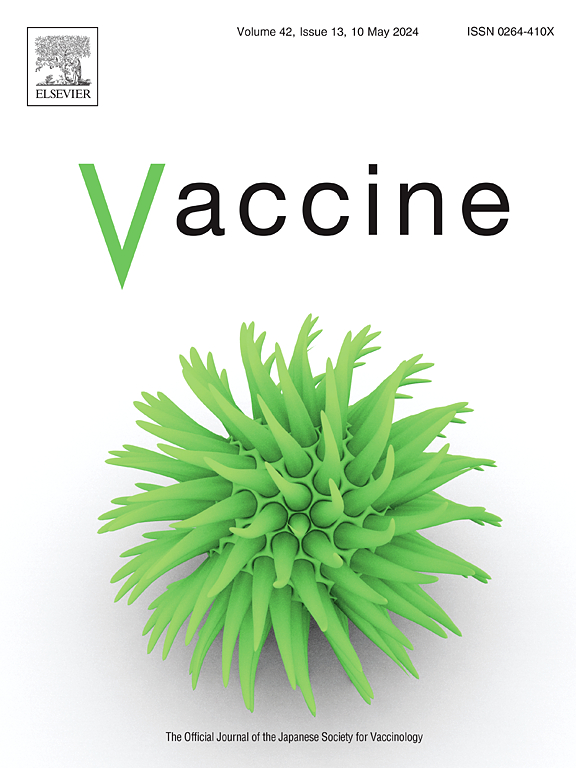一项3期随机、双盲临床研究,评估V116与流感疫苗联合应用于50岁或以上成人的安全性和免疫原性
IF 4.5
3区 医学
Q2 IMMUNOLOGY
引用次数: 0
摘要
背景:由肺炎链球菌引起的疾病在成人中具有相当高的发病率和死亡率。V116是一种经批准的21价肺炎球菌结合疫苗,其血清型组合物旨在解决成人中大多数残留的肺炎球菌疾病。这项3期研究评估了成人与四价流感疫苗(QIV)联合使用V116的安全性、耐受性和免疫原性。方法将1080名年龄≥50岁的健康成人按1:1随机分组,分别接受QIV和V116联合治疗(n = 540)或30 d后接受QIV和V116联合治疗(n = 540)。接种疫苗后30天,采用V116的opsonophagocytic活性(OPA)几何平均滴度(GMTs)和免疫球蛋白G (IgG)几何平均浓度(GMCs)和QIV的血凝抑制(HAI) GMTs来评估免疫原性。对于V116,组间非劣效性的统计标准要求OPA - GMT比值(伴随/序列组)的双侧95%置信区间下界为>;0.5. 对于QIV,非劣效性的统计标准要求HAI GMT比值(伴随/序贯组)的双侧95% CI下限为0.67。通过不良事件(ae)参与者的比例来评估安全性。结果合并组在V116的21个血清型中有20个达到了主要的非效性免疫原性终点,在QIV的4个流感毒株中有3个达到了主要的非效性终点;血清型23B和流感H3N2的非劣效性标准被遗漏。所有V116血清型疫苗接种后30天的IgG gmc在各组之间具有可比性。注射部位、全身、疫苗相关和严重ae的参与者比例在两组之间一般具有可比性。结论在≥50岁的成人中,V116与QIV合用具有良好的耐受性和免疫原性。研究结果支持在QIV中使用V116。本文章由计算机程序翻译,如有差异,请以英文原文为准。
A phase 3 randomized, double-blind clinical study to evaluate the safety and immunogenicity of V116 when administered concomitantly with influenza vaccine in adults 50 years of age or older
Background
Disease caused by Streptococcus pneumoniae is associated with considerable morbidity and mortality in adults. V116 is an approved 21-valent pneumococcal conjugate vaccine with a serotype composition designed to address the majority of residual pneumococcal disease in adults. This phase 3 study evaluated the safety, tolerability, and immunogenicity of V116 when administered concomitantly with quadrivalent influenza vaccine (QIV) in adults.
Methods
A total of 1080 healthy adults ≥ 50 years of age were randomized 1:1 to receive QIV and V116 concomitantly (n = 540) or QIV followed by V116 30 days later (n = 540). Immunogenicity was evaluated at 30 days postvaccination using opsonophagocytic activity (OPA) geometric mean titers (GMTs) and immunoglobulin G (IgG) geometric mean concentrations (GMCs) for V116, and hemagglutination inhibition (HAI) GMTs for QIV. For V116, the statistical criterion for noninferiority between groups required the lower bound of the 2-sided 95 % confidence interval of the OPA GMT ratio (concomitant/sequential groups) to be > 0.5. For QIV, the statistical criterion for noninferiority required the lower bound of the 2-sided 95 % CI of the HAI GMT ratio (concomitant/sequential groups) to be >0.67. Safety was evaluated by the proportion of participants with adverse events (AEs).
Results
The concomitant group met the primary noninferiority immunogenicity endpoints for 20 of 21 serotypes in V116 and for 3 of 4 influenza strains in QIV; noninferiority criteria were narrowly missed for serotype 23B and influenza H3N2. IgG GMCs at 30 days postvaccination were generally comparable between groups for all V116 serotypes. The proportions of participants with injection-site, systemic, vaccine-related, and serious AEs were generally comparable between groups.
Conclusions
In adults ≥ 50 years of age, V116 is well tolerated and immunogenic when given concomitantly with QIV. Study results support use of V116 with QIV.
求助全文
通过发布文献求助,成功后即可免费获取论文全文。
去求助
来源期刊

Vaccine
医学-免疫学
CiteScore
8.70
自引率
5.50%
发文量
992
审稿时长
131 days
期刊介绍:
Vaccine is unique in publishing the highest quality science across all disciplines relevant to the field of vaccinology - all original article submissions across basic and clinical research, vaccine manufacturing, history, public policy, behavioral science and ethics, social sciences, safety, and many other related areas are welcomed. The submission categories as given in the Guide for Authors indicate where we receive the most papers. Papers outside these major areas are also welcome and authors are encouraged to contact us with specific questions.
 求助内容:
求助内容: 应助结果提醒方式:
应助结果提醒方式:


